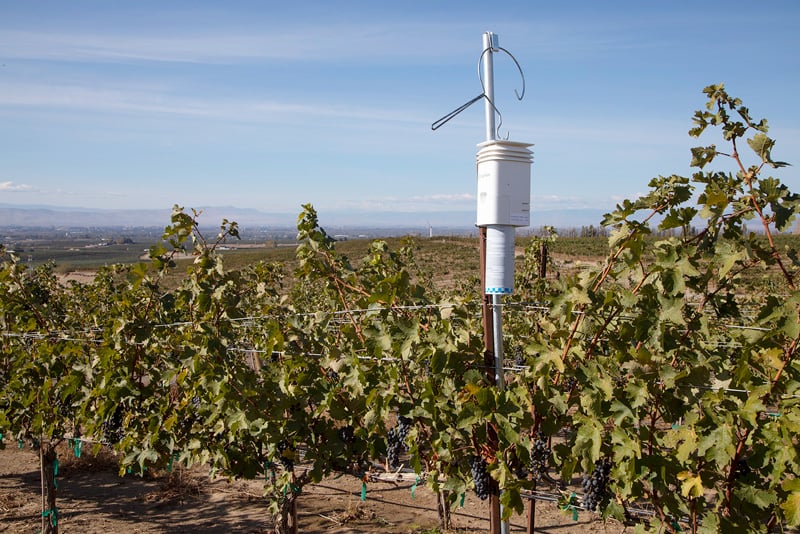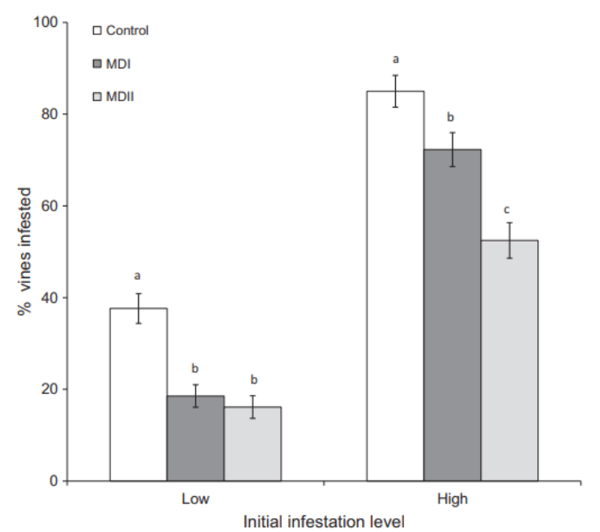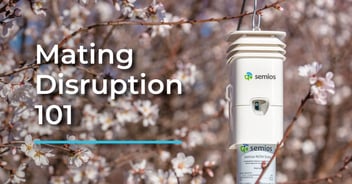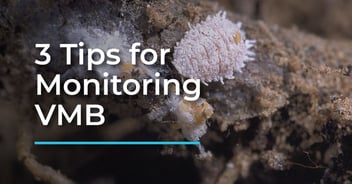Vine mealybug (VMB) is one of the most important pests affecting California grapes. They feed on the sap which can weaken vines, and they also produce sticky secretions known as honeydew which can promote sooty mold growth.
Most concerningly, VMB and other mealybugs are also an important vector of pathogens including grapevine leafroll-associated viruses.
Part of the challenge with vine mealybug control is their cryptic nature. A part of the population resides underneath the bark which protects them from insecticides and often makes chemical coverage a challenge.
Mating disruption can be an effective tool in the arsenal for vine mealybug control. Mating disruption is when sex pheromones, which are used by adult males to locate females, are released in large amounts into the atmosphere so that communication and mating is impacted.
Mating disruption is not only safe for beneficial insects, but is also not dependent on direct contact with the pest. Once applied, pheromone will be released from the source and will propagate through the vineyard by diffusion and wind movement.
 Figure 1. A Semios VMB pheromone dispenser hanging in a vineyard
Figure 1. A Semios VMB pheromone dispenser hanging in a vineyard
Mating disruption reduces vine mealybug infestations
Studies have shown that year-over-year mating disruption of VMB can keep mealybug populations in check.
Mating disruption reduces vine mealybug populations by reducing the number of matings and/or delaying matings. Delaying the age at which females mate can dramatically reduce the number of viable eggs produced.
Study in Northern Israel
A study conducted in Northern Israel found that blocks that had been under one and two years of mating disruption had reduced male captures and fewer vines infested by VMB compared to untreated blocks (Sharon et al 2016).
In vineyards with low infestations (< 50% infested vines), the percentage of infested vines was reduced by half for blocks with mating disruption for one or two years. In highly infested vineyards (>70% infested vines) the percentage of infested vines was reduced by 38% in blocks treated with mating disruption for two years (Figure 2.).

Figure 2. Mean (土SE) percentage of infested vines in plots treated using the mating disruption method against vine mealybug, grouped according to initial level of infestation (low and high). Means within a group capped with different letters are significantly different (ANOVA followed by Tukey’s test: P<0.05). Control: No mating disruption, MDI: Under mating disruption for one year, MDII: Under mating disruption for 2 years. Reproduced from Sharon et al 2016
Study in California, USA
A similar finding occurred in a three-year area-wide mating disruption study in Napa County (2011-2013) done by Kent Daane and colleagues (Hogg et al 2021).
They found VMB trap captures, which correlate well with the level of VMB infestations of grapes at harvest, were reduced in mating disrupted treated blocks supplemented with insecticide compared to blocks treated with insecticides alone.
What’s more, the removal of mating disruption in the third year led to an increase in trap captures of VMB in certain sites with low initial VMB densities, suggesting that lower captures in previous years was due to the presence of mating disruption.
A mating disruption program is a marathon, not a sprint
When first adopting mating disruption in your vineyard, remember it may take a few years of diligent insecticide usage in order to get populations to a low level that can be maintained by mating disruption.
That is because, at high levels of infestations, males have a higher chance of encountering females by chance despite pheromone communications being disrupted. But once established, mating disruption can prove to be a valuable tool in the integrated pest management toolbox against VMB.
 Figure 3. A member of the Semios Field Services Team installing a pheromone dispenser in a vineyard
Figure 3. A member of the Semios Field Services Team installing a pheromone dispenser in a vineyard
Learn More
Semios Vine Mealybug (VMB) Mating Disruption Solution and Crop Management Platform for Grape Growers
References
Daane, K. M., Cooper, M. L., Mercer, N. H., Hogg, B. N., Yokota, G. Y., Haviland, D. R., ... & Boyd, E. A. (2021). Pheromone Deployment Strategies for Mating Disruption of a Vineyard Mealybug. Journal of Economic Entomology, 114(6), 2439-2451.
Hogg, B. N., Cooper, M. L., & Daane, K. M. (2021). Areawide mating disruption for vine mealybug in California vineyards. Crop Protection, 105735.
Sharon, R., Zahavi, T., Sokolsky, T., Sofer‐Arad, C., Tomer, M., Kedoshim, R., & Harari, A. R. (2016). Mating disruption method against the vine mealybug, P lanococcus ficus: effect of sequential treatment on infested vines. Entomologia Experimentalis et Applicata, 161(1), 65-69.
Resources
University of California (UC) Agriculture and Natural Resources Vine Mealybug Page



